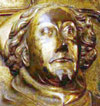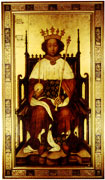Portraits of Richard II
There are many crowned images of Richard II on seals, in manuscripts and on charters, but these are not 'portraits'. Three large-scale representations, however, are known from the last decade of the reign.
The Wilton Diptych
The Wilton Diptych was painted around the time of Richard's second marriage in 1396, when he was nearly thirty, but he is shown as a beardless youth as he might have appeared at the time of his coronation, when he was not yet eleven. Technical examination has shown that the head was painted in after the surrounding areas were completed. For a more detailed look at the Diptych, see the Wilton Diptych page.
The Westminster Portrait
The over life-size portrait which now hangs in the nave of Westminster Abbey depicts Richard as a fully mature man with a small forked beard. The anonymous portrait is painted in a linseed oil medium on panel. It probably dates from the 1390s, but was heavily restored in 1732 and again in 1866, making it hard to judge its qualities. Besides much overpainting, the background of stamped and gilded gessogesso - prepared surface of plaster under gilding or paint was also removed during the 1866 restoration, apart from the small area to the right of the king's head. This is now thought to have been original. Infra-red photography has revealed the monumental qualities of the underdrawing. The throne has been much altered, but the head is probably substantially intact.
Portraits dating from the fourteenth century are exceptionally rare north of the Alps and this full-length image has no parallels. It may always have been in the Abbey church and may perhaps have been part of a rigid structure such as a pew. The first mention of it is in 1611, when it was in the choir. The frame decorated with Richard II's arms and badges was designed in 1866 by Sir Gilbert Scott.
This majestic portrait has sometimes been connected with a hostile passage suggestive of Richard's tyranny by the Eulogium writer (probably a Franciscan friar of Canterbury writing in the early fifteenth century), see C. Given-Wilson (ed. and transl.), Chronicles of the revolution, 1397- 1400. The king is described as sitting enthroned, requiring his courtiers to kneel whenever his gaze fell upon them:
'After this on solemn festivals when by custom [Richard II] performed kingly rituals, he would order a throne to be prepared for him in his chamber on which he liked to sit ostentatiously from after dinner until vespers, talking to noone but watching everyone; and when his eye fell on anyone, regardless of rank, that person had to bend his knee towards the king ...'
(Continuatio Eulogii, pp. 371-9)
The effigy in Westminster Abbey

Effigy of Richard II. Detail (London, Westminster Abbey).
Like the Westminster portrait, the effigy ordered in 1395 for Richard's double tomb with Anne of Bohemia, represents Richard as a mature and bearded adult.The coppersmiths' contract stipulated that they were to work from a pattern, and that Richard's effigy was to 'imitate the figure (corps)' of the king. Richard was no doubt portrayed as he wished to be seen. The head and hood of the effigy were cast separately from the body. Work on the effigies may have been complete as early as March 1396. All the metal elements of the tomb were in place when payments were made for gilding between December 1398 and April 1399. This is around the time the treasure roll was compiled.

